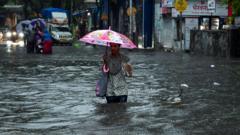Mumbai and other metropolitan areas are hitting the headlines again as relentless monsoon rains bring infrastructure to its knees. Streets transform into rivers, public transport faces disruption, and residents are left feeling exasperated and exposed. This year's pre-monsoon downpour left many neighborhoods in Mumbai submerged well before the actual monsoon season commenced, revealing the city’s frailty in handling water management. The Brihanmumbai Municipal Corporation (BMC), responsible for Mumbai’s infrastructure, attributed the chaos to drains clogged with debris and construction waste. However, quick measures such as installing de-watering pumps came too late for many affected residents.
This flooding phenomenon isn't isolated to Mumbai; it's a national crisis. Cities like Delhi and Bengaluru face similar challenges each monsoon season, resulting in road collapses and traffic nightmares. Experts emphasize that the rampant pace of unplanned urban expansion, combined with outdated drainage systems, has laid the groundwork for these disasters. As urban landscape morphs, past infrastructures struggle to keep pace, leaving vital natural water channels and wetlands neglected and built over.
The monsoon season, crucial for India's agricultural sector, jeopardizes millions of lives across the country. With climate change amplifying erratic weather patterns, the severity of monsoon rains has intensified. This year alone, southern India experienced an early monsoon, catching local authorities off-guard, as atmospheric depressions influenced weather patterns from the Arabian Sea.
Historical burdens add to the problem, especially seen at the notorious Minto bridge in Delhi, which embodies the city’s eternal battle against urban flooding. The monsoon deluge in May led to property damage and casualties, revealing a pattern across major cities. Bengaluru, once renowned for its lakes, now faces flooding due to relentless encroachment of its water bodies, transforming natural flood management systems into urban sprawl.
Experts argue that the solution isn’t simple, as every city presents unique geographical and climatic challenges. Instead of reactive responses to disaster, a long-term coherent strategy is crucial. Urban planning must incorporate innovative technologies such as real-time sensors and mapping to alert communities about flood risks and implement informed responses.
Only a paradigm shift in urban design and community engagement can mitigate future flooding risks. As the annual monsoon crisis unfolds, it’s evident: India’s cities require transformative action to create a sustainable, resilient urban future.
This flooding phenomenon isn't isolated to Mumbai; it's a national crisis. Cities like Delhi and Bengaluru face similar challenges each monsoon season, resulting in road collapses and traffic nightmares. Experts emphasize that the rampant pace of unplanned urban expansion, combined with outdated drainage systems, has laid the groundwork for these disasters. As urban landscape morphs, past infrastructures struggle to keep pace, leaving vital natural water channels and wetlands neglected and built over.
The monsoon season, crucial for India's agricultural sector, jeopardizes millions of lives across the country. With climate change amplifying erratic weather patterns, the severity of monsoon rains has intensified. This year alone, southern India experienced an early monsoon, catching local authorities off-guard, as atmospheric depressions influenced weather patterns from the Arabian Sea.
Historical burdens add to the problem, especially seen at the notorious Minto bridge in Delhi, which embodies the city’s eternal battle against urban flooding. The monsoon deluge in May led to property damage and casualties, revealing a pattern across major cities. Bengaluru, once renowned for its lakes, now faces flooding due to relentless encroachment of its water bodies, transforming natural flood management systems into urban sprawl.
Experts argue that the solution isn’t simple, as every city presents unique geographical and climatic challenges. Instead of reactive responses to disaster, a long-term coherent strategy is crucial. Urban planning must incorporate innovative technologies such as real-time sensors and mapping to alert communities about flood risks and implement informed responses.
Only a paradigm shift in urban design and community engagement can mitigate future flooding risks. As the annual monsoon crisis unfolds, it’s evident: India’s cities require transformative action to create a sustainable, resilient urban future.


















